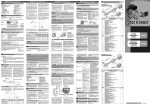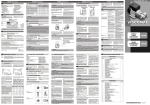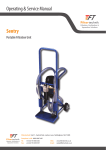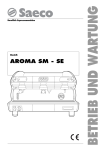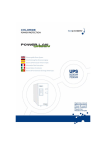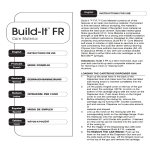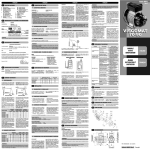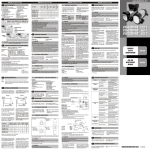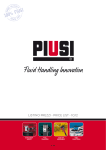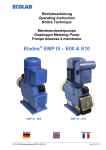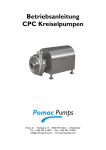Download english use and maintenance manual deutsch bedienungs
Transcript
A INHALTSVERZEICHNIS Inhaltsverzeichnis Angaben zu Maschine und Hersteller Quasimaschinen-Einbauerklärung Maschinenbeschreibung Technische Daten E1 Leistungen E2 Elektrische Daten F Betriebsbedingungen F1 Umgebungsbedingungen F2 Stromversorgung F3 Arbeitszyklus F4 Zulässige / unzulässige Fluide G Beförderung und Transport H Installation H1 Entsorgung der Verpackung E2 A B C D E B DEUTSCH (Übersetzt aus dem Italienischen) H2 H3 H4 H5 I L M N O P Q R S Vorkontrollen Mechanischer Einbau Hydraulikanschluß Anmerkungen zu Förder- und Ansaugleitungen H6 Elektroanschlüsse Erster Start Täglicher Einsatz Probleme und deren Behebung Wartung Geräuschentwicklung Entsorgung von verseuchtem Material Raumbedarf und Gewicht Übersichtsbildtafeln und Ersatzteile Konfiguration Förderleistung und Saugleistung HERSTELLER: Modèles disponibles: • VISCOMAT 350/2 DREIPHASIG 400V/50HZ • VISCOMAT 200/2 DREIPHASIG 400V/50HZ PIUSI SPA VIA PACINOTTI - Z.I. RANGAVINO 46029 SUZZARA (MN) PRODUKTCODE MODELL TECHNISCHE MERKMALE BEDIENUNGSANLEITUNG ACHTUNG Vergewissern Sie sich stets, daß die Revision der vorliegenden Bedienungsanleitung mit der auf dem Typenschild angegebenen Revision übereinstimmt. QUASIMASCHINEN-EINBAUERKLÄRUNG Die unterzeichnete Firma: PIUSI S.p.A - Via Pacinotti c.m. - z.i.Rangavino 46029 Suzzara (Mantua) - Italien ERKLÄRT auf ihre eigene Verantwortung, dass die Quasimaschine: Bezeichnung: Modell: Maschinennummer: Baujahr: Pumpe zum Ümfüllen von Schmierölen VISCOMAT GEAR siehe Losnummer auf dem am Produkt angebrachten CE Typenschild siehe Baujahr auf dem am Produkt angebrachten CE Typenschild den Gesetzesbestimmungen entspricht, die folgende Richtlinien umsetzen: - Maschinenrichtlinie 2006/42/EG - Niederspannungsrichtlinie 2006/95/EG - Richtlinie über die elektromagnetische Verträglichkeit 2004/108/EG Es wurden die wesentlichen Sicherheitsanforderungen angewandt und eingehalten, die in Anlage I der Maschinenrichtlinie angeführt sind, die für das Produkt anwendbar und nachstehend aufgelistet sind: 1.1.3 - 1.1.5 - 1.3.1 - 1.3.2 - 1.3.3 - 1.3.4 - 1.3.8 - 1.4.1 - 1.4.2.1 - 1.5.1 - 1.5.2 - 1.5.4 1.5.5 - 1.5.8 - 1.5.11 - 1.6.1 - 1.6.3 - 1.6.4 - 1.7.1 - 1.7.2 - 1.7.3 - 1.7.4. Die Dokumentation steht der zuständigen Behörde auf begründetes Verlangen bei der Firma Piusi S.p.A. oder Beantragung unter der E-Mail Adresse: [email protected] zur Verfügung. Die zur Erstellung des technischen Heftes und Abfassung der Erklärung autorisierte Person ist Herr Otto Varini in seiner Eigenschaft als gesetzlicher Vertreter. Suzzara, 29/12/20109 E Strom Spannung Frequenz Nenn (V) (Hz) (Watt) 230 50 550 4 1450 VISCOMAT 200/2 EINPHASIG 230V/60HZ AC 230 60 550 4.7 1700 VISCOMAT 200/2 DREIPHASIG 400V/50HZ AC 400 50 550 1.5 1450 VISCOMAT 350/2 EINPHASIG 230V/50HZ AC 230 50 900 6.3 1450 VISCOMAT 350/2 DREIPHASIG 400V/50HZ AC 400 50 750 2.5 1450 VISCOMAT 230/3 230V/50HZ AC 230 50 900 6 1400 VISCOMAT 230/3 400V/50HZ 15 400 50 750 2.7 1400 ACHTUNG Die Leistungsaufnahme der Pumpe hängt vom Betriebspunkt und von der Viskosität des gepumpten Öls ab. Die in der Tabelle angegebenen Daten zum SPITZENSTROM beziehen sich auf Pumpen, die im Punkt maximaler Verdichtung P max mit Ölen läuft, deren Viskosität etwa bei 500 cSt liegt. der gesetzliche Vertreter Selbstansaugende Elektrozahnradkapselpumpe mit Innenprofil und By-pass-Ventil. Einphasen- oder Drehstromasynchronmotor, 2-polig oder 4-polig, geschlossene Bauweise (Schutzklasse IP55 gemäß Richtlinie EN 60034-5-86) eigenbelüftet, direkt am Pumpengehäuse angeflanscht. TECHNISCHE DATEN wird, den die Pumpe überwinden muß. Im Diagramm "A" wird eine für alle Pumpenmodelle der Familie VISCOMAT typische Kurve Saugleistung/Gegendruck illustriert. Die Verwendung des einen oder des anderen Ansaugstutzens hat keine Auswirkungen auf die Pumpenleistungen, die praktisch in beiden Fällen gleich bleiben. Trotzdem ist bei der Entscheidung über die Installation zu beachten, daß sie auf eine möglichst kurze und gerade Saugleitung zwischen dem Behälter und der Pumpe gezielt sein muß, um die Saugbedingungen zu optimieren. Pumpenfüllung zum Ausscheiden der eventuell in der Installation vorhandenen Luft dient. Die Vorrichtung verfügt über einen 1,5 m langen Schlauch, der in den Ansaugtank einzuführen ist. ZUM TANK Falls die Installation mit einem Grundventil versehen ist, kann man die Füllvorrichtung nach Beendigung der Startphase schließen (siehe Abschnitt "I"). Will man hingegen das Entlüftungsventil immer offen lassen, ist auch zu berücksichtigen, daß ein Anteil des Öldurchflusses gleich 0.5 ÷ 1 l/min im Behälter umläuft (siehe Abschnitt "I"). ACHTUNG STROMVERSORGUNG Die höchsten, akzeptablen Abweichungen bei den elektrischen Parametern sind folgende: Spannung: Frequenz: +/- 5% vom Nennwert +/- 2% vom Nennwert Sich vergewissern, daß der Entlüftungsschlauch nicht in das Öl des Entnahmebehälters getaucht wird, weil in diesem Fall die Füllvorrichtung nicht funktionieren könnte. INSTALLATION EINES DRUCKWÄCHTERS automatischen Betriebs/Stoppens des Pumpenelektromotors vorgesehen, muß dieser stromab der Füllvorrichtung angebracht werden. Ist ein Druckwächter zur Steuerung des FÜLLVORRICHTUNG RÜCKSCHLAGVENTIL (falls am Pressostat nicht integriert) DRUCKWÄCHTERS ARBEITSZYKLUS Die Motoren sind für Dauerbetrieb ausgelegt. Unter normalen Betriebsbedingungen können sie im Dauerbetrieb ohne Einschränkungen arbeiten. Ein Betrieb unter By-pass-Bedingungen ist nur kurzzeitig (höchstens 2-3 Minuten) zulässig. Sollte bei einer besonderen Anwendung die Gefahr bestehen, daß für längere Zeit im By-pass gearbeitet wird, ist es unbedingt erforderlich, dafür zu sorgen, daß die bypassierte Saugleistung nicht im Inneren der Pumpe umgewälzt wird, sondern wieder in den Ansaugbehälter zurückgeführt wird. ZULÄSSIGE / UNZULÄSSIGE FLUIDE ZULÄSSIG SIND: • ÖL mit einer VISKOSITÄT von 50 bis 2000 cSt (bei Betriebstemperatur) UNZULÄSSIG SIND: • BENZIN • ENTZÜNDLICHE FLÜSSIGKEITEN mit PM < 55°C • WASSER • LEBENSMITTELFLÜSSIGKEITEN • KORROSIVE, CHEMISCHE PRODUKTE H BESTEHENDE GEFAHR: • BRAND - EXPLOSION • BRAND - EXPLOSION • ANROSTEN DER PUMPE • VERSEUCHUNG DERSELBEN • KORROSION DER PUMPE PERSONENSCHADEN • BRAND - EXPLOSION SCHÄDEN AN DEN DICHTUNGEN BEFÖRDERUNG UND TRANSPORT Vor dem Versand werden die Pumpen sorgfältig verpackt. Überprüfen Sie die Verpackung bei Erhalt und lagern Sie die Pumpe an einem trockenen Ort. ACHTUNG Verfügt die Füllvorrichtung nicht über ein Rückschlagventil, muß ein solches zwischen der Füllvorrichtung und dem Druckwächter angebracht werden. H4 Saugleistun [Q] l/min Saugleistung [Q] l/min Diagramm “A” • Vergewissern Sie sich, daß sich in den Rohrleitungen und im Ansaugtank keinerlei Schlacken oder Rückstände des Gewindeschnitts befinden, die die Pumpe und deren Zubehör beschädigen könnten. • Setzen Sie immer einen Filter mit Metallsieb am Ansaugrohr ein. • Bevor Sie die Förderleitung anschließen, füllen Sie das Pumpengehäuse teilweise mit Öl, um zu vermeiden, daß die Pumpe beim Füllen nicht trocken läuft. • Beim Anschließen der Pumpenmodelle mit BSP-Gewinde (Kegelgasanschluß) keinesfalls Verbindungsstücke mit kegeligem Gewinde verwenden. Zu starkes Anziehen dieser Verbindungsstücke könnte zu Schäden an den Stutzen der Pumpe führen. Die empfohlenen MINDEST-Merkmale für die Leitungen sind folgende: ANSAUGLEITUNG - Durchmesser: - Nenndruck: 1" 2 mal der Druck P Bypass (siehe Tabelle im Abschnitt E1 - LEISTUNGEN) - für Unterdruckbetrieb geeignet FÖRDERLEITUNG - Durchmesser: - Nenndruck: 1/2" 2 mal der Druck P Bypass (siehe Tabelle im Abschnitt E1 - LEISTUNGEN) INSTALLATION Gegendruck [P] bar Punkt "1" ist der Betriebspunkt, in dem fast kein Gegendruck vorhanden ist und in dem die Pumpe die maximale Saugleistung (Q max) erbringt. Im Punkt "2" besteht hingegen der maximale Gegendruck (P max), in diesem Punkt erbringt die Pumpe die geringste Saugleistung (Q min). Sobald der Gegendruck den Wert P max übersteigt, wird der By-pass selbst dank seiner speziellen Konformation plötzlich geöffnet, was zu einer ebenso umgehenden Reduzierung der Saugleistung führt. Bei einer Ansaugleistung gleich null (Punkt PUMPENMODELL umweltbelastend ist. Hinsichtlich der Entsorgung beachten Sie die lokalen Verordnungen. Gegendruck [P] bar "3") wird die gesamte Saugleistung der Pumpe in By-pass umgewälzt, und der Druck der Förderleitung erreicht den Wert P By-pass. Die Pumpen VISCOMAT sind daher in der Lage, mit einem beliebigen Gegendruck zwischen Null und P max zu laufen und dabei eine nur gering in Abhängigkeit vom Gegendruck variierende Leistung erbringen, die zwischen den Werten Q max und Q min Iiegt. Die Werte für Q min, Q max, P max, P by-pass, werden für jedes einzelne Modell in der untenstehenden Tabelle angegeben: Q max Q min (Liter/min) (Liter/min) P max (bar) P by-pass (bar) VISCOMAT 200/2 EINPHASIG 230V/50HZ 12 9 11 15 VISCOMAT 200/2 EINPHASIG 230V/60HZ 12 9 11 15 VISCOMAT 200/2 DREIPHASIG 400V/50HZ 12 9 11 15 VISCOMAT 350/2 EINPHASIG 230V/50HZ 12 9 25 30 VISCOMAT 350/2 DREIPHASIG 400V/50HZ 12 9 25 30 VISCOMAT 230/3 230V/50HZ 15 13.5 16 19 VISCOMAT 230/3 400V/50HZ 15 13.5 16 19 Die Pumpen VISCOMAT sind in der Lage, Ölsorten mit sehr unterschiedlicher Viskosität zu pumpen, ohne daß der By-pass deswegen verstellt werden müßte. Die Viskosität muß jedoch innerhalb der Grenzen liegen, die in den TECHNISCHEN DATEN angegeben sind. Die typische Kurve Ansaugleistung/Gegendruck, wie im Diagramm "A" veranschaulicht, bezieht sich auf den Betrieb mit Öl, daß eine Viskosität von etwa 110cSt (die beispielsweise bei dem Öl SAE W80 bei einer Temperatur von 45°C auftritt) aufweist. ENTSORGUNG DER VERPACKUNG Für das Verpackungsmaterial sind keine besonderen Vorkehrungen zur Entsorgung zu treffen, da es weder gefährlich noch Diagramm “B” Sobald die Viskosität des Öls sich ändert, verändern sich die Leistungen der Pumpe in dem Maße, wie der Gegendruck, unter dem die Pumpe arbeitet, zunimmt. Das Diagramm "B" zeigt, wie sich die typische Kurve im Falle der höchsten und der niedrigsten Viskosität (jeweils bei 50 cSt und bei 500 cSt) verändert. Wie man sieht, verändert sich die Ansaugleistung Q min beim höchsten Arbeitsgegendruck (Pmax) um 10% bis 15% gegenüber dem Wert, der bei einer Viskosität von 110 cSt auftritt. H2 H3 Die Verwendung von Rohren bzw. Bauteilen, die nicht für die Verwendung mit Öl geeignet sind und deren Nenndruck nicht angemessen ist, können Personen- und Sachschäden sowie Umweltbelastung hervorrufen. Auch das Lockern von Verbindungen (Gewindeverbindungen, Flanschverbindungen, Dichtungen) kann zu Personen- und Sachschäden sowie Umweltbelastung führen. Nach dem Einbau und im Anschluß daran in regelmäßigen und angemessenen Abständen sind alle Verbindungen zu überprüfen. VORKONTROLLEN • Vergewissern Sie sich, daß die Maschine beim Transport oder bei der Lagerung nicht beschädigt wurde. • Reinigen Sie die Ansaug- und Förderstutzen und entfernen Sie möglichen Staub oder Verpackungsreste. • Vergewissern Sie sich, daß die Motorwelle frei dreht. • Vergewissern Sie sich, daß die elektrischen D a t e n d e n a u f d e m Ty p e n s c h i l d angegebenen Daten entsprechen. Die Pumpen der Serie Viscomat können auf folgende zwei Weisen installiert werden: H5 ANMERKUNGEN ZU FÖRDER- UND ANSAUGLEITUNGEN FÖRDERUNG Bei der Wahl des zu verwendenden Pumpenmodells müssen die Viskosität des zu pumpenden Öls und die Merkmale der Anlage auf der Förderseite der Pumpe berücksichtigt werden. Die Kombination aus Viskosität des Öls und Merkmalen der Anlage kann in der Tat einen Gegendruck erzeugen, der über dem vorgesehenen Höchstdruck (gleich P max) liegt, der ein (teilweises) Öffnen des By-pass ANSAUGUNG b) An der Wand, mit nach oben schauendem Pumpenkörper: c) An der Wand, mit seitlich liegendem Pumpenkörper: werden, vermieden werden. • Sollte die Anlagen ganz aus metallenen Rohrleitungen oder in jedem Fall aus Leitungen mit hoher Steifigkeit bestehen, sollte die Möglichkeit in Betracht gezogen werden, Die Einphasenmotoren sind mit zweipoligem Schalter und Kondensatoren ausgestattet, die im Inneren des Klemmbretts verkabelt und angeschIossen sind (siehe Schaltplan). Die Motoren sind außerdem mit einem Überhitzungsschutz mit selbsttätiger Rückstellung ausgerüstet. Die Merkmale des Kondensators sind für jedes Modell auf dem Typenschild der Pumpe angegeben. Der Schalter hat Ein-/Ausschaltfunktion für die Pumpe und kann keinesfalls den Hauptschalter ersetzen, den die anwendbaren Richtlinien vorsehen. ACHTUNG PROBLEME UND DEREN BEHEBUNG DER MOTOR LÄUFT NICHT Die Pumpen der Serie VISCOMAT zeichnen sich durch eine ausgezeichnete Ansaugleistung aus. Die typische Kurve Saugleistung/Gegendruck bleibt bis in hohe Unterdruckwerte hinein bei der Ansaugung der Pumpe unverändert. Bei Ölsorten mit Viskosität bis höchstens 100 cSt kann der Unterdruck an der Ansaugung Werte zwischen 0,7 - 0,8 bar erreichen, ohne den einwandfreien Betrieb der Pumpe zu beeinträchtigen. Oberhalb besagter Unterdruckwerte beginnt die Hohlsogbildung, die sich durch eine stärkere Geräuschentwicklung während des Betriebs bemerkbar macht. Diese Hohlsogbildung kann mit der Zeit zur Beschädigung der Pumpe und darüber hinaus zu einem Leistungsabfall führen. Je mehr die Viskosität zunimmt, um so geringer wird der Unterdruck, bei dem Hohlsogbildung der Pumpe mit daraus folgender, merklicher Reduzierung der Saugleistung zur Folge hat. In diesem Fall ist es erforderlich, die Widerstände der Anlage durch Verwendung kürzerer Rohre bzw. von Rohren mit größerem Durchmesser zu reduzieren, damit der einwandfreie Betrieb der Pumpe bei gleicher Viskosität des gepumpten Öls gewährleistet ist. Da es im Gegenzug nicht möglich ist, die Anlage zu verändern, muß ein Pumpenmodell mit höherem P max gewählt werden. auftreten kann. Bei Ölsorten mit Viskosität von etwa 500 cSt darf der Unterdruck an der Ansaugung Werte zwischen 0,3 - 0,5 bar nicht überschreiten, um Hohlsogbildung zu vermeiden. Die oben angegebenen Richtwerte beziehen sich auf die Ansaugung von Ölsorten, die im wesentlichen keine Luft aufweisen. Falls das gepumpte Öl in emulgierter Form mit Luft vorliegt, kann die Hohlsogbildung bereits bei geringerem Unterdruck auftreten. In jedem Fall ist es im Rahmen der obigen Ausführungen wichtig, an der Ansaugung niedrigen Unterdruck zu gewährleisten (kurze Leitungen und mit größerem Durchmesser als der Durchmesser des Ansaugstutzens der Pumpe; geringe Anzahl von Kurven; Filter mit großem Querschnitt, die stets sauber gehalten werden). ACHTUNG In der Anlagentechnik sollte es selbstverständlich sein, ober- und unterhalb der Pumpe Unterdruckmesser und Manometer einzubauen, um überprüfen zu können, ob die Betriebsbedingungen im Rahmen der vorgesehenen Bedingungen liegen. Es wird empfohlen, ein Grundventil einzubauen, damit sich die Ansaugleitung beim Abstellen der Pumpe nicht entleert. DER MOTOR LÄUFT BEIM STARTEN LANGSAM Im Lieferumfang der Pumpen sind keine elektrischen Sicherheitsvorrichtungen wie Schmelzdrahtsicherungen, Motorschutz, Systeme gegen unbeabsichtigtes Starten nach Stromausfall oder andere enthalten. Der Monteur, der die elektrischen Anschlüsse ausführt, ist für die Einhaltung der anwendbaren Richtlinien verantwortlich. sich unter Bezugnahme auf Abschnitt R RAUMBEDARF UND GEWICHT, daß die Drehrichtung korrekt ist. • Alle Motoren sind mit Erdungsklemme versehen, die an die Erdung des Netzes angeschlossen werden muß. • Schließen Sie stets den Deckel des Klemmbretts, bevor Sie die Stromversorgung wieder einschalten, nachdem Sie die Unversehrtheit der Dichtungen überprüft haben, die die Schutzklasse IP55 gewährleisten. ERSTER START Die Pumpen der Serie VISCOMAT sind selbstansaugend und daher in der Lage, Öl aus dem Tank auch dann anzusaugen, wenn die Ansaugleitung beim Starten leer ist. Die Saughöhe (Abstand zwischen Ölspiegel im Tank und Ansaugstutzen) darf nicht mehr als 2,5 Meter betragen. ACHTUNG Versorgen der Pumpe mit Flüssigkeit. Vor dem Anlassen der Pumpe anhand der Ein- und Auslaßstutzen das Innere des Pumpenkörpers mit Öl benetzen. Wurde die Pumpe bereits installiert, zum Verrichten dieses Vorgangs den Gewindeverschluß des nicht verwendeten Einlaßstutzens (IN1 oder IN2) abschrauben, die innere Kammer mit Öl füllen und den Verschluß wieder anschrauben. Auf den O-Ring zur Abdichtung achten. Bei der Füllphase muß die Pumpe die anfänglich in der Leitung enthaltene Luft ausstoßen. Deshalb muß man das Ventil der Füllvorrichtung (Pos. 32 auf der Explosionszeichnung) gegen Uhrzeigersinn drehen, so daß die vorhandene Luft ausgeschieden wird. Wenn sich der Schlauch mit Öl gefüllt hat, ist die Luftbeseitigungsphase beendet. Sollte sich diese Phase über Gebühr hinausziehen, schalten Sie die Pumpe ab und vergewissern sich: • daß die Pumpe nicht völlig "trocken" läuft; • daß das Eindringen von Luft in die Ansaugleitung nicht möglich ist und die Leitung selbst sich korrekt in der anzusaugenden Flüssigkeit befindet; • daß der eventuelle Filter in der Ansaugung nicht verstopft ist; • daß die Saughöhe 2,5 Meter nicht überschreitet; • daß die Luft aus der Förderleitung leicht entweichen kann. Sobald der Füllvorgang abgeschlossen ist und die Abgabepistole eventuell wieder montiert wurde, vergewissern Sie sich, daß die Pumpe im gesamten, vorgesehenen Bereich arbeitet. L Kontrollieren Sie dazu möglichst folgendes: 1) Der Leistungsbedarf des Motors muß unter maximalen Leistungsbedingungen innerhalb der auf dem Typenschild angegebenen Werte liegen. 2) Der Unterdruck an der Ansaugung darf die in Abschnitt H5 - ANMERKUNGEN ZU FÖRDERUND ANSAUGLEITUNGEN angegebenen Grenzwerte nicht überschreiten. 3) Der Gegendruck auf der Förderseite darf die in Abschnitt H5 - ANMERKUNGEN ZU FÖRDER- UND ANSAUGLEITUNGEN angegebenen Grenzwerte nicht überschreiten. Zwecks korrekter und umfassender Überwachung der Punkte 2) und 3) sollten oberhalb undunterhalb der Pumpe Unterdruckmesser und Manometer eingebaut werden. TÄGLICHER EINSATZ Vor dem täglichen Einsatz der Pumpen VISCOMAT ist keine besondere Vorkehrung zu treffen. HANDBETRIEB • Vor dem Starten der Pumpe vergewissern Sie sich, daß das eventuelle, abschließende Sperrorgan (Abgabepistole oder Leitungsventil) geschlossen ist. • Falls auf der Förderseite keine Sperre eingebaut ist (freie Förderung), vergewissern Sie sich, daß die Förderleitung richtig positioniert und in einer entsprechenden Aufnahme am Fördertank befestigt ist. • Den Betriebsschalter, der an einigen (einphasigen) Pumpenmodellen vorhanden ist, oder den Ein-/Aus-Schalter an der Versorgungsleitung betätigen. • Vergewissern Sie sich, daß im Tank eine zur Abgabe ausreichende Menge Öl vorhanden ist (Trockenlaufen kann die Pumpe beschädigen). ACHTUNG • Das Förderventil öffnen oder die Abgabepistole betätigen und sie dabei gut festhalten. Behebung Keine Stromversorgung Elektrische Anschlüsse und Sicherheitssysteme kontrollieren Probleme am Motor Rotierende Organe auf mögliche Schäden oder Verstopfungen hin überprüfen Warten, bis der Motor abgekühlt ist. Den erneuten Start überprüfen und die Ursache für die Übertemperatur suchen Kundendienst anrufen Niedrige Versorgungsspannung Die Spannung wieder in die vorgesehenen Grenzen bringen Rotor blockiert Niedriger Stand im Ansaugtank Die Öltemperatur überprüfen und das Öl eventuell anheizen, um die übermäßige Viskosität zu reduzieren Den Tank füllen Grundventil blockiert Das Ventil reinigen bzw. auswechseln Filter verstopft Überhöhter Ladeverlust im Förderkreislauf (Betrieb mit geöffnetem By-pass) Den Filter reinigen Die Pumpe gegenüber dem Ölstand im Tank niedriger setzen oder den Querschnitt der Leitungen erhöhen Kürzere Leitungen oder Leitungen mit größerem Durchmesser verwenden By-pass-Ventil blockiert Das Ventil ausbauen, reinigen bzw. auswechseln Eindringen von Luft in die Pumpe oder in die Ansaugleitung Überprüfen, ob die Verbindungen dicht sind Verengung am Ansaugrohr Ein für den Betrieb mit Unterdruck angemessenes Rohr verwenden Niedrige Drehzahl Die Spannung an der Pumpe kontrollieren; die Spannung regulieren bzw. Kabel mit größerem Querschnitt erwenden Die Ansaugleitung liegt am Boden des Tanks Die Leitung anheben Übermäßige Viskosität des Öls Die Öltemperatur überprüfen und das Öl eventuell anheizen, um die übermäßige Viskosität zu reduzieren Hohlsogbildung Den Unterdruck an der Ansaugung reduzieren (siehe Abschnitt H5) Unregelmäßiger By-passBetrieb Abgeben, bis die im By-pass-System vorhandene Luft entwichen ist Luft im Öl Warten, bis sich das Öl im Tank gesetzt hat Beschädigung der mechanischen Dichtung Die mechanische Dichtung überprüfen und ggf. auswechseln Überhöhte Viskosität des Öls Übermäßiger Unterdruck in der Ansaugung GERINGE ODER KEINE SAUGLEISTUNG HOHE GERÄUSCHENTWICKLUNG DER PUMPE LECKAGE AM PUMPEGEHÄUSE N GERÄUSCHENTWICKLUNG Unter normalen Betriebsbedingungen überschreitet die Geräuschentwicklung bei allen P ENGLISH BEDIENUNGSUND WARTUNGSANLEITUNG DEUTSCH Modellen den Wert von 70 dB "A" in 1 Meter Entfernung zur Elektropumpe nicht. ENTSORGUNG VON VERSEUCHTEM MATERIAL Bei Wartung oder Ausschlachtung der Maschine umweltbelastende Teile umweltgerecht in den entsprechenden Deponien Q USE AND MAINTENANCE MANUAL WARTUNG Die Pumpen der Serie Viscomat sind für eine minimale Wartung konzipiert und gebaut. • Einmal wöchentlich kontrollieren, ob die mutzungen entfernen. Verbindungen der Rohrleitungen nicht locker • Einmal monatlich die Filter oberhalb der sind, um eventuelle Leckagen zu vermeiden. Pumpe kontrollieren und sauber halten. • Einmal monatlich das Pumpengehäuse • Einmal monatlich die Stromversorgungskontrollieren und eventuelle Verschkabel auf Ihren guten Zustand hin kontrollieren. O Wurde kein Grundventil installiert, empfiehlt es sich, das Entlüftungsventil immer offen zu lassen, damit die Vorrichtung bei der nächsten Anlassung schon bereitgestellt ist, um die im Saugschlauch enthaltene Luft auszustoßen. Bitte berücksichtigen Sie, daß während des Betriebs ein kleiner Anteil des Öldurchflusses im Behälter umläuft. Ist hingegen ein Grundventil vorhanden, empfiehlt es sich, das Entlüftungsventil zu schließen, indem man es im Uhrzeigersinn dreht, so daß es keine unnötigen Ölumläufe im Behälter gibt. Dichtet das Grundventil nicht perfekt ab, könnte sich der Saugschlauch entleeren und folglich muß der o. g. Luftbeseitigungsvorgang wiederholt werden. Mögliche Ursache Der Motorüberhitzungsschutz greift ein ACHTUNG • Beim Einbaus und bei Wartungsarbeiten vergewissern Sie sich, daß die Stromversorgungsleitungen nicht unter Spannung stehen. • Verwenden Sie Kabel mit Mindestquerschnitten und Nennspannungen und achten Sie darauf, daß auch die Art der Verlegung den im Abschnitt E2 - ELEKTRISCHE DATEN angegebenen Merkmalen und der Installationsumgebung entspricht. • Bei Drehstrommotoren vergewissern Sie einen leistungsfähigen Akku einzubauen, um zu vermeiden, daß auch Leckagen geringen Ausmaßes (beispielsweise am Grundventil) einen Druckabfall verursachen, der zum automatischen Einschalten der Pumpe führt. Mangelnde Beachtung obiger Angaben kann zu Schäden an der Pumpe führen. Problem ZUM MOTOR Bulletin M0040B EN/DE - Rev. 1 DEUTSCH (Übersetzt aus dem Italienischen) M ZUM MOTOR Starten Sie die Pumpe keinesfalls durch bloßes Einstecken des Steckers in die Steckdose! MECHANISCHER EINBAU a) Mit waagrechter Achse: EINPHASIG Das Füllen kann, je nach Anlage, einige Sekunden bis wenige Minuten in Anspruch nehmen. HYDRAULIKANSCHLUSS ACHTUNG H1 öffnen Sie den Deckel am Klemmbrett, entfernen Sie besagtes Kabel und schließen Sie die Leitung nach folgendem Schaltplan an. ACHTUNG ACHTUNG Aufgrund des geringen Gewichts und der geringen Abmessungen der Pumpen (siehe Platzbedarf) ist der Einsatz von Hebezeugen zum Befördern der Pumpen nicht erforderlich. DREIPHASIG WS I Die Stromversorgung über Leitungen, deren Werte sich außerhalb der angegebenen Grenzen befinden, kann zu Schäden an den elektrischen Bauteilen führen. G Alle Motoren sind mit einem kurzen Kabel ausgestattet, das für Produktionstests verwendet wird. Zum Anschließen des Motors an die Leitung Beachten Sie folgende (nicht erschöpfende) Angaben zwecks korrekter Elektroinstallation: ACHTUNG F3 ELEKTRISCHE ANSCHLÜSSE Bei der Lieferung ist der Stutzen "IN2" durch einen Gewindeverschluß mit "O-Ring" verschlossen und die Pumpe ist zum Gebrauch unter Verwendung des Stutzens "IN1" vorbereitet. Will man den Stutzen "IN2" verwenden, muß man den Gewindeverschluß und den O-Ring des Stutzens "IN2" entfernen und am Stutzen "IN1" anbringen. Zur leichteren Installation hat der Pumpenkörper zwei Ansaugstutzen: - Der Stutzen "IN1" ist mit dem Förderstutzen "OUT" ausgerichtet. - Der Stutzen "IN2" liegt parallel zur RELATIVE LUFTFEUCHTIGKEIT: max. 90% Die angegebenen Grenztemperaturen beziehen sich auf die Bauteile der Pumpe und müssen eingehalten werden, um mögliche Schäden oder Störungen zu vermeiden. Es versteht sich jedoch, daß der effektive Betriebstemperaturbereich für ein bestimmtes Öl auch von der Veränderlichkeit der Viskosität des Öls selbst in bezug auf die Temperatur abhängt. Insbesondere gilt folgendes: • Die zulässigen Mindesttemperaturen (-10°C) können die Viskosität einiger Ölsorten weit über die zulässigen Höchsttemperaturen hinaus ansteigen lassen. Dies kann es dann mit sich bringen, daß der beim Starten der Pumpe erforderliche Anlaufdrehmoment exzessiv ist, was wiederum zu Überströmen und Beschädigung der Pumpe führen kann. • Die zulässigen Höchsttemperaturen (+60°C) können wiederum die Viskosität einiger Ölsorten weit unter die zulässigen Mindesttemperaturen sinken lassen. Dies kann zu einem Abfall der Leistung mit evidenter Reduzierung der Saugleistung in dem Maße führen, wie der Gegendruck ansteigt. Je nach Pumpenmodell hat die Stromversorgung über eine Drehstrom- oder eine Einphasenleitung mit Wechselstrom zu erfolgen, deren Nennwerte in der Tabelle im Abschnitt E2 - ELEKTRISCHE DATEN angegeben sind. H6 Motorachse und folglich 90° im Vergleich zum Förderstutzen "OUT". Die Pumpen der Serie Viscomat sind mit einer, am Förderstutzen OUT angebrachten Füllvorrichtung ausgerüstet, die bei der UMGEBUNGSBEDINGUNGEN LEISTUNGEN Die Leistungen der einzelnen Pumpenmodelle aus der Familie VISCOMAT können mit Hilfe von Kurven veranschaulicht werden, in denen das Verhältnis von Saugleistung und Gegendruck angegeben Die Pumpe anhand Schrauben angemessenen Durchmessers an den vorhandenen Befestigungslöchern befestigen (siehe Zeichnung "Außenmaße und Gewichte)". ACHTUNG F4 MASCHINENBESCHREIBUNG ACHTUNG Es wird davon abgeraten, die Pumpe mit senkrechter Achse und nach unten schauendem Pumpenkörper anzubringen. Sollte dies unvermeidbar sein, ist die Installation eines Grundventils erforderlich und beim ersten Anlassen muß man den Saugschlauch mit Öl füllen. FÜLLVORRICHTUNG BETRIEBSBEDINGUNGEN TEMPERATUR: min. -10°C / max. +60°C Anlage auch nach der ersten Füllung sofort und leicht wieder zu verwenden. DEUTSCH (Übersetzt aus dem Italienischen) ACHTUNG • LÖSUNGSMITTEL E1 Spitzen Nenn (Amp) (U/Min) AC F2 die zum Einbau in eine Maschine (oder Zusammensein mit anderen Maschinen) bestimmt ist, um eine Maschine zu bilden, für die die Maschinenrichtlinie 2006/42/EG gilt, so lange nicht in Betrieb gesetzt werden darf, bis die Maschine, in die sie eingebaut wird, als konform mit den Bestimmungen der Richtlinie 2006/42/EG erklärt wird; MOTOR: LEISTUNG STROM DREHZAHL VISCOMAT 200/2 EINPHASIG 230V/50HZ F1 BAUJAHR PUMPE: STROMVERSORGUNG PUMPENMODELL F TYPENSCHILD (BEISPIEL MIT ANGABE DER EINZELNEN FELDER): D Es wird nahegelegt, stets ein Rückschlagventil anzubringen, das es ermöglicht, die ELEKTRISCHE DATEN ANGABEN ZU MASCHINE UND HERSTELLER Erhältliche Modelle: • VISCOMAT 200/2 EINPHASIG 230V/50HZ • VISCOMAT 200/2 EINPHASIG 230V/60HZ • VISCOMAT 350/2 EINPHASIG 230V/50HZ C DEUTSCH (Übersetzt aus dem Italienischen) KONDENSATOR DEUTSCH (Übersetzt aus dem Italienischen) entsorgen. Beachten Sie die lokalen Vorschriften zur korrekten Entsorgung. ÜBERSICHTSBILDTAFELN UND ERSATZTEILE VISCOMAT 200/2 Position 1 2 3 4 5 6 7 8 9 10 11 12 13 14 15 16 17 18 20 21 22 23 24 25 26 27 28 29 30 31 32 Bauteilbezeichnung SCHRAUBE UNI 9327 M8X50-8.8 ZN PUMPENKNOPF MIT GEWINDE DICHTUNG O-RING 3118 VERSCHLUSS G1"X15 DICHTUNG O-RING 3068 DISTANZSTÜCK Ø14 BY-PASS VERSCHLUSS BY-PASS VENTIL ZYLINDRISCHE DRUCKSCHRAUBENFEDER STIFT Ø 5X14 ZUGSTAB M5X145 FLANSCH MEC71, GEDREHT MOTOR LAUFRADDECKEL AUS KUNSTSTOFF FEDERKEIL LAGER 6203 MIT 2 SCHUTZSCHIRMEN AUSGLEICHSRING SCHLAGSCHRAUBE M6X25 DIN 7500/C PUMPENFLANSCH DICHTUNG O-RING 123 ORTSFESTE RUTSCHENSEITE Ø14 DREHENDE RUTSCHENSEITE Ø14 DICHTUNG O-RING 117 MESSINGSCHEIBE KEGELFEDER SEEGER FÜR SCHAFT AUSSENROTOR H12 INNENROTOR H12 DICHTUNG O-RING MUTTER UNI 5588 M5 - 5S ZN ENTLÜFTUNGSSATZ Menge 3 1 1 1 1 1 1 1 1 2 4 1 1 1 1 1 1 4 1 1 1 1 1 1 1 1 1 1 1 4 1 ACHTUNG Aus der Pistole, die über die Pumpe VISCOMAT gespeist wird, tritt das Fluid unter hohem Druck aus. Richten Sie die Mündung der Pistole keinesfalls auf Teile des Körpers. • Schließen Sie die Abgabepistole oder das Leitungsventil, um die Abgabe zu unterbrechen. Die Pumpe begibt sich automatisch in den By-pass-Modus. ACHTUNG Der By-pass-Betrieb mit geschlossener Förderleitung ist nur kurzzeitig (höchstens 2-3 Minuten) gestattet. Sobald der Überhitzungsschutz ausgelöst wird, ist die Stromversorgung zu unterbrechen und es muß gewartet werden, bis der Motor abgekühlt ist. • Abstellen der Pumpe. AUTOMATIKBETRIEB Bei besonderen Anwendungen kann es angebracht sein, das automatische Ein- und Ausschalten der Pumpe mit Hilfe eines Pressostats vorzusehen, daß den Druck in der Förderleitung erfaßt. Die Betriebslogik stellt sich bei derartigen Installationen wie folgt dar: • Die Pumpe steht, die Abgabepistole ist geschlossen und die Förderleitung steht unter Druck. • Die Pistole wird geöffnet, was zu einem plötzlichen Abfall des Drucks an der Förderleitung führt. • Das Pressostat sorgt dafür, daß in dem Moment, in dem der Druck unter den Wert "Pm" absinkt, die Pumpe automatisch eingeschaltet wird und die Abgabe erfolgen kann. • Während der Abgabe arbeitet die Pumpe mit einem Gegendruck, der von den Bedingungen in der Förderleitung abhängig ist und der über oder unter dem Druck "Pm" liegen kann. • Sobald die Pistole geschlossen wird, steigt der Druck rasch wieder an und das Pressostat sorgt dafür, daß die Pumpe automatisch abgeschaltet wird, sobald der Druck den Wert "Pa" übersteigt. Die Werte "Pa" und "Pm" sind für das verwendete Pressostat typisch und können oftmals innerhalb eines bestimmten Bereiches reguliert werden.. Für einen einwandfreien und sicheren Betrieb der Pumpe ist es bei derartigen Anwendungen absolut unerläßlich, daß folgende Punkte geprüft werden: • Der "Pa" muß angemessen unter dem Bypass-Druck liegen, damit gewährleistet ist, daß die Pumpe abschaltet, sobald die Pistole geschlossen wird und vermieden wird, daß die Pumpe längere Zeit im By-pass-Modus arbeitet. • Der "Pm" muß um einige Bar unter dem "Pa" liegen, um der Gefahr eines unerwarteten Anlaufens der Pumpe bei minimaler Reduzierung des Drucks vorzubeugen, die nicht auf das Öffnen der Pistole zurückzuführen ist. • Das Grundventil muß wirkungsvolles Abdichten gewährleisten, damit unerwünschte und häufige Ein-/Ausschaltzyklen, die durch dessen Lecken verursacht VISCOMAT 350/2 Position 1 2 3 4 5 6 7 8 9 10 11 12 13 14 15 16 17 18 19 20 21 22 23 24 25 26 27 28 29 30 32 Bauteilbezeichnung VERSCHLUSS G1"X15 DICHTUNG O-RING 3118 PUMPENKNOPF MIT GEWINDE BY-PASS VENTIL ZYLINDRISCHE DRUCKSCHRAUBENFEDER DICHTUNG O-RING 3068 DISTANZSTÜCK Ø14 BY-PASS VERSCHLUSS STIFT Ø5X14 SPANNSTANGE M5X160 FLANSCH MEC80, GEDREHT SCHLAGSCHRAUBE M6X25 DIN 7500/C MOTOR LAUFRADDECKEL AUS KUNSTSTOFF FEDERKEIL LAGER 6204 MIT 2 SCHUTZSCHIRMEN AUSGLEICHSRING PUMPENFLANSCH DICHTUNG O-RING 123 ORTSFESTE RUTSCHENSEITE Ø14 DREHENDE RUTSCHENSEITE Ø14 DICHTUNG O-RING 117 MESSINGSCHEIBE KEGELFEDER SEEGER FÜR SCHAFT AUSSENROTOR H12 INNENROTOR H12 DICHTUNG O-RING SCHRAUBE UNI 9327 M8X50-8.8 ZN MUTTER UNI 5588 M5 - 5S ZN ENTLÜFTUNGSSATZ Menge 1 1 1 1 1 1 1 1 2 4 1 4 1 1 1 1 1 1 1 1 1 1 1 1 1 1 1 1 3 4 1 Bulletin M0040B EN/DE - Rev. 1 Copyright A E2 INDEX A Index B Identification of Machine and Manufacturer C Declaration of Incorporation of partly-completed Machinery D Machine Description E Technical Information E1 Performance E2 Electrical Information F Operating Conditions F1 Environmental Conditions F2 Electrical Power F3 Working Cycle F4 Fluids Allowed / Fluids Not Allowed G Moving and Transporting H Installation B ENGLISH (Translated from Italian) I L M N O P Q R S H1 Disposing of the Packing Materials H2 Preliminary Inspection H3 Mechanical Installation H4 Hydraulic Connection H5 Suction & Delivery Lines H6 Electrical Connections Initial Start-Up Every Day Use Problems and Solutions Maintenance Noise Level Disposal of Contaminated Materials Exploded Diagrams and Spare Parts Dimensions and Weights Configuration of Delivery and Suction ELECTRICAL INFORMATION ELECTRIC POWER SUPPLY PUMP MODEL POWER CURRENT Current Voltage Frequency Rated (V) (Hz) (Watt) SPEED Maximum Rated (Amp) (g/m) VISCOMAT 200/2 SINGLE-PHASE 230V/50HZ AC 230 50 550 4 1450 VISCOMAT 200/2 SINGLE-PHASE 230V/60HZ AC 230 60 550 4.7 1700 VISCOMAT 200/2 THREE-PHASE 400V/50HZ AC 400 50 550 1.5 1450 VISCOMAT 350/2 SINGLE-PHASE 230V/50HZ AC 230 50 900 6.3 1450 VISCOMAT 350/2 THREE-PHASE 400V/50HZ AC 400 50 750 2.5 1450 VISCOMAT 230/3 230V/50HZ AC 230 50 900 6 1400 VISCOMAT 230/3 400V/50HZ 15 400 50 750 2.7 1400 IDENTIFICATION OF MACHINE AND MANUFACTURER Available Models: Modèles disponibles: • VISCOMAT 200/2 SINGLE-PHASE 230V/50HZ • VISCOMAT 350/2 THREE-PHASE 400V/50HZ • VISCOMAT 200/2 SINGLE-PHASE 230V/60HZ • VISCOMAT 200/2 THREE-PHASE 400V/50HZ • VISCOMAT 350/2 SINGLE-PHASE 230V/50HZ MANUFACTURER: PIUSI SPA VIA PACINOTTI - Z.I. RANGAVINO 46029 SUZZARA (MN) PRODUCT CODE F1 PRODUCTION YEAR MODEL TECHNICAL DATA MANUAL ATTENTION Always check that the revision level of the present manual agrees with the revision level indicated on the label. DECLARATION OF INCORPORATION OF PARTLY-COMPLETED MACHINERY The undersigned: ENVIRONMENTAL CONDITIONS is intended to be incorporated in a machine (or to be with other machines) so as to create a machine to which applies Machine Directive 2006/42/EC, may not be brought into service before the machine into which it is to be incorporated has been declared in conformity with the provisions of the directive 2006/42/EC. is in conformity with the legal provisions indicated in the directives: - Machine Directive 2006/42/EC - Low-Voltage Directive 2006/95/EC - Electromagnetic Compatibility Directive 2004/108/EC To which the essential safety requirements have been applied and complied with what indicated on annex I of the machine directive applicable to the product and shown below: 1.1.3 - 1.1.5 - 1.3.1 1.3.2 - 1.3.3 - 1.3.4 - 1.3.8 - 1.4.1 - 1.4.2.1 - 1.5.1 - 1.5.2 - 1.5.4 - 1.5.5 - 1.5.8 - 1.5.11 - 1.6.1 - 1.6.3 1.6.4 - 1.7.1 - 1.7.2 - 1.7.3 - 1.7.4. The documentation is at the disposal of the competent authority following motivated request at Piusi S.p.A. or following request sent to the email address: [email protected] The person authorised to compile the technical file and draw up the declaration is Otto Varini as legal representative. Suzzara, 29/12/2009 The temperature limits indicated are applied to the pump components and must be respected to avoid possible damage or malfunction. It is understood, nevertheless, that for a given oil, the real functioning temperature range also depends on the variability of the viscosity of the oil itself with the temperature. Specifically: • The minimum temperature allowed (-10°C) could cause the viscosity of some oils to greatly exceed the maximum allowed, with the consequence that the static torque required during the starting of the pump would be excessive, risking overload and damage to the pump. • The maximum temperature allowed (+60°C) could, on the other hand, cause the viscosity of some oils to drop well below the minimum allowed, causing a degradation in performance with obvious reductions in flow rate as the back pressure increases. ELECTRICAL POWER Depending on the model, the pump must be fed by three-phase or single-phase alternating current whose nominal values are those indicated in the Table of paragraph E2 - ELECTRICAL INFORMATION. The maximum acceptable variations from the electrical parameters are: voltage: +/- 5% of the nominal value frequency: +/- 2% of the nominal value PUMP: Electric self-priming rotary internal gear pump, equipped with a by-pass valve. MOTOR: Asynchronous motor, single-phase or three-phase, 2 or 4 pole, closed type (Protection class IP55 according to regulation EN 60034-5-86) self-ventilating, flange-mounted directly to the pump body. E TECHNICAL INFORMATION F3 pressure that the pump must overcome. Diagram "A" illustrates a flow rate/back pressure curve typical of all of the pumps in the VISCOMAT family. Functioning in by-pass conditions is only allowed for brief periods (2 to 3 minutes maximum). Whenever a particular installation carries the risk of functioning in by-pass mode for longer periods of time, it is necessary that the by-passed flow not be recirculated inside the pump, but be returned to the suction tank. FLUIDS ALLOWED / FLUIDS NOT ALLOWED ALLOWED: • OIL with a VISCOSITY from 50 to 2000 cSt (at working temperature) G Back pressure [P] bar Point "1" is the point at which the pump is functioning with practically no back pressure, in which case the pump supplies the maximum flow rate (Q max). Po i n t " 2 " i s t h e f u n c t i o n i n g p o i n t characterized by the maximum back pressure (P max) at which the pump supplies the minimum flow rate (Q min). When the back pressure exceeds the value P max, thanks to the special design of the by-pass, there is a sudden opening of the by-pass, with a consequent sudden reduction of the flow rate supplied. PUMP MODEL Flow rate [Q] l/min Flow rate [Q] l/min H Diagram “A” H1 Diagram “B” RELATED DANGER: • FIRE - EXPLOSION • FIRE - EXPLOSION • OXIDATION OF THE PUMP • CONTAMINATION OF SAME • CORROSION OF THE PUMP INJURY TO PEOPLE • FIRE - EXPLOSION DAMAGE TO GASKET SEALS MOVING AND TRANSPORTING The pumps are carefully packed before shipment. On receipt, check the packing materials and store in a dry place. DISPOSING OF THE PACKING MATERIALS in any way dangerous or polluting. For disposal, refer to local regulations. Back pressure [P] bar H2 At flow rate zero (point "3") the entire flow rate supplied by the pump is recirculated in the by-pass, and the pressure in the delivery line reaches the value of P By-pass. VISCOMAT pumps can, therefore, function in the face of any back pressure between zero and P max, supplying a flow rate varying little as a function of the back pressure between the values of Q max and Q min. The values for Q min , Q max , P max and P by-pass are provided for each model of pump in the Table below: TO THE TANK If the system is equipped with a foot valve, the priming device can be closed once the starting phase has been completed (see paragraph "I"). If you wish to leave the purge valve always open, remember that a small quantity of oil recirculates in the tank at a 0.5 ÷ 1 l/min flow rate. Make sure that the air discharge tube is not immersed in the oil inside the drawing tank. In this case, the operation of the priming device may be prejudiced. INSTALLING A PRESSURE SWITCH automatic on/off piloting of the pump electric motor, this is to be installed downstream of the priming device. PRIMING DEVICE VNON-RETURN VALVE (if not integrated into the pressure switch) PRESSURE SWITCH Q max. Q min. (liters/min) (liters/min) P max. (bar) P by-pass (bar) 9 11 15 VISCOMAT 200/2 SINGLE-PHASE 230V/60HZ 12 9 11 15 VISCOMAT 200/2 THREE-PHASE 400V/50HZ 12 9 11 15 VISCOMAT 350/2 SINGLE-PHASE 230V/50HZ 12 9 25 30 VISCOMAT 350/2 THREE-PHASE 400V/50HZ 12 9 25 30 VISCOMAT 230/3 230V/50HZ 15 13.5 16 19 VISCOMAT 230/3 400V/50HZ 15 13.5 16 19 the pump's performance will be more noticeable the greater the back pressure against which the pump is working. Diagram "B" illustrates how the characteristic curve changes in the case of the maximum and minimum viscosities (respectively equal to 50 cSt and 500 cSt), showing that, at the maximum working back pressure (Pmax), the flow rate Q min suffers a variation of between 10% and 15% with respect to the value relative to a viscosity of 110 cSt. H3 • Make sure that the motor shaft turns freely. • Check that the electrical information corresponds with what is shown on the label. MECHANICAL INSTALLATION The Viscomat series pumps can be installed in the following two ways: a) On an horizontal base: THREE PHASE A.C. LINE terminal strip cover, remove the above mentioned cable and connect the line according to the following chart. SINGLE PHASE TO MOTOR Single-phase motors are supplied with a bipolar switch and capacitors wired and installed inside the terminal strip box (see chart). Motors are likewise equipped with an automatic reset thermo-protector. The capacitor characteristics are those indicated on the pump label. The switch has the function of starting/stopping the pump and cannot in any way replace the main power switch required by the applicable regulations. I correct rotation direction by referring to paragraph R - DIMENSIONS AND WEIGHTS. • All motors are equipped with a grounding terminal that is to be connected to the ground line of the electrical system. • Always close the cover of the terminal strip box before turning on the electric power, after checking the integrity of the gasket seals that ensure protection grade IP55. MOTOR TURNS SLOWLY WHEN STARTING ATTENTION If the priming device is not equipped with a non-return valve, it is necessary to install one between the priming device and the pressure switch. H4 HYDRAULIC CONNECTION • Make sure that the hoses and the suction tank are free of dirt and filing residue that might damage the pump and accessories. • Always install a metal mesh filter in the suction hose. • Before connecting the delivery hose, partially fill the pump body with oil to avoid the pump running dry during the priming phase. • When connecting pump models furnished with BSP threading (cylindrical gas) do not use joints with a conical thread. Excessive tightening of these could cause damage to the pump openings. The MINIMUM recommended characteristics for hoses are as follows: SUCTION HOSE - diameter: - nominal pressure: 1" 2 times the pressure P bypass (see the Table in paragraph E1 - PERFORMANCE) ATTENTION Wetting the pump. Before starting the pump, wet the inside of the pump body with oil through the inlet and outlet openings. If the pump is already installed, the wetting operation can be performed by unscrewing the threaded plug of the inlet opening (IN-1 or IN-2) not in use, by filling the internal chamber with oil and screwing in the plug, paying attention to the O-ring seal. In the priming phase the pump must blow the air that was initially present in the suction hose into the line. Therefore, it is necessary to rotate the valve of the priming device anticlockwise to position "32" of the exploded drawing in order to purge the air present in the system. When the tube is filled with oil, the purging phase is concluded. The use of hoses and/or line components that are inappropriate for use with oil or have inadequate nominal pressures can cause damage to objects or people as well as pollution. The loosening of connections (threaded connections, flanges, gasket seals) can likewise cause damage to objects or people as well as pollution. Check all of the connections after installation and on a regular on-going basis with adequate frequency. The priming phase may last from several seconds to a few minutes, depending on the characteristics of the system. ranges, possibly checking: 1) that under conditions of maximum flow the energy drawn by the motor falls within the values indicated on the label 2) that the suction pressure does not exceed the limits indicated in paragraph H5 SUCTION & DELIVERY LINES 3) that the back pressure in the delivery line does not exceed the values indicated in paragraph H5 - SUCTION & DELIVERY LINES For a complete and proper verification of points 2) and 3), the installation of vacuum and air pressure gauges at the inlet and outlet of the pump is recommended. EVERY DAY USE No particular preliminary operation is required for every day use of VISCOMAT pumps. MANUAL OPERATION • before starting the pump, make sure that the ultimate shut-off device (delivery gun or line valve) is closed. If the delivery has no shut-off device (free delivery) make sure that it is correctly positioned and appropriately attached to the delivery tank. • turn the on-switch present on some pump models (single-phase) or the start/stop switch installed on the electrical power line. • make sure that the tank is filled with a quantity of oil greater than the quantity to be supplied (running dry could damage the pump). ATTENTION Never start the pump by simply inserting the plug in the outlet. H5 SUCTION & DELIVERY LINES LITTLE OR NO FLOW Thermal motor protector has triggered Wait until the motor cools, verify that it starts again, look for the cause of overheating Problems with the motor Low voltage from the electrical power supply Contact technical support Adjust the voltage within anticipated limits Verify oil temperature and warm it to reduce excessive viscosity Fill the tank Clean and/or replace valve Clean the filter Lower the pump with respect to the level of the tank or increase the cross-section of the hose Excessive oil viscosity High load loss in the delivery circuit (running with by-pass open) Use shorter hose or of wider diameter By-pass valve blocked Detach the valve, clean or replace it Check the seal of the connections Use a hose appropriate for working under suction pressure Check the voltage at the pump. Adjust the voltage or use cables of greater cross-section Air in the pump or suction hose Narrowing of the suction hose Low rotation speed HIGHER PUMP NOISE Suction hose resting on the bottom of the tank Raise the hose Excessive oil viscosity Verify oil temperature and warm it to reduce excessive viscosity Reduce the suction pressure (see paragraph H5) Deliver until the air in the by-pass system is purged Wait for the oil in the tank to settle Check and replace the mechanical seal • Open the delivery valve or activate the delivery gun, gripping it securely. Irregular by-pass functioning Presence of air in the oil N Damage to the mechanical seal THREE-PHASE 3-PHASIGER VISCOMAT 200/2 MAINTENANCE VISCOMAT series pumps are designed and constructed to require a minimal amount of maintenance. • On a weekly basis check that the hose joints • On a monthly basis check and clean the have not loosened, to avoid any leakage. filters placed at the pump inlet. • On a monthly basis check the pump body • On a monthly basis check that the electric and clean it removing any impurities. power cables are in good condition. O If a foot-valve is installed, close the air purge valve by turning it clockwise, so that no oil circulates in the tank. If the foot-valve seal is not perfectly tight, the suction tube may be emptied and the purging operation described above must be repeated. L 1/2" 2 times the pressure P bypass (see the Table in paragraph E1 - PERFORMANCE) Rotor blocked Check electrical connections and safety systems Check for possible damage or obstruction to rotating parts Excessive suction pressure LEAKAGE FROM THE PUMP BODY - appropriate for use with suction DELIVERY HOSE - diameter: - nominal pressure: Corrective action Lack of power Cavitation VISCOMAT series pumps are self-priming and, therefore, able to draw oil from the tank even when the suction hose is empty on start-up. The priming height (distance between the surface of the oil and the inlet opening) must not exceed 2,5 meters. If this phase is excessively prolonged, stop the pump and verify: • that the pump is not running completely "dry" • that the suction hose guarantees against air infiltration and is correctly immersed in the fluid to be drawn • that any filters installed are not blocked • that the priming height is not greater than 2,5 meters • that the delivery hose allows for the easy evacuation of the air. When priming has occurred, after reattaching the delivery gun, verify that the pump is functioning within the anticipated Possible cause Low level in the suction tank Foot valve blocked Filter blocked INITIAL START-UP VISCOMAT 350/2 NOISE LEVEL Under normal operating conditions noise emission for all models does not exceed the P value of 70 dB "A" at a distance of 1 Meter from the electric pump. DISPOSAL OF CONTAMINATED MATERIALS In the case of maintenance or destruction of the machine, do not disperse contaminated Q THREE-PHASE 3-PHASIGER parts into the environment. Refer to local regulations for their proper disposal. EXPLODED DIAGRAMS AND SPARE PARTS R DIMENSIONS AND WEIGHTS RAUMBEDARF UND GEWICHTE VISCOMAT 200/2 Position 1 2 3 4 5 6 7 8 9 10 11 12 13 14 15 16 17 18 20 21 22 23 24 25 26 27 28 29 30 31 32 Component Description SCREW UNI 9327 M8X50-8.8 ZN MACHINED PUMP HEAD O-RING 3118 PLUG G1"X15 O-RING 3068 SPACER Ø 14 BY-PASS PLUG BY-PASS VALVE COMPRESSION HELICAL SPRING PIN Ø 5X14 TIE ROD M5X145 FLANGE MEC71, TURNED MOTOR PLASTIC FAN COVER TONGUE BEARING 6203 WITH TWO PROTECTION SCREENS COMPENSATING RING THREAD FORMING SCREW M6X25 DIN 7500/C PUMP FLANGE O-RING 123 FIXED CHUTE FACE Ø14 ROTARY CHUTE FACE Ø14 O-RING 117 BRASS WASHER CONIC SPRING SEEGER FOR SHAFT EXTERNAL ROTOR H12 INTERNAL ROTOR H12 O-RING NUT UNI 5588 M5 - 5S ZN VENTING KIT VISCOMAT 200/2 Quantity 3 1 1 1 1 1 1 1 1 2 4 1 1 1 1 1 1 4 1 1 1 1 1 1 1 1 1 1 1 4 1 direction of rotation Drehsinn VISCOMAT 350/2 ATTENTION DELIVERY The choice of pump model to use should be made keeping in mind the viscosity of the oil to be pumped and the characteristics of the system attached to the delivery of the pump. The combination of the oil viscosity and the characteristics of the system could, in fact, create back pressure greater than the anticipated maximums (equal to P max), so as to cause the (partial) opening of the pump by-pass with a consequent noticeable reduction of the flow rate supplied. In such a case, in order to permit the correct functioning of the pump equal to the viscosity of the oil being pumped, it will be necessary to reduce resistance in the system by employing shorter hoses and/or of larger diameter. On the other hand, if the system cannot be modified it will be necessary to select a pump model with a higher P max. Fluid exits at high pressure from a delivery gun fed by a VISCOMAT pump. Never point the outlet of the gun towards any part of the body. • Close the delivery gun or the line valve to stop delivery. The pump will immediately enter by-pass mode ATTENTION Running in by-pass mode with the delivery closed is only allowed for brief periods (2 to 3 minutes maximum). When the thermo-protector trips, turn-off the electric power and wait for the motor to cool. • Stop the pump. c) To the wall, with pump body aside: MOTOR DOES NOT TURN ATTENTION ATTENTION SUCTION b) To the wall, with pump body upwards: PROBLEMS E SOLUTIONS Pumps are supplied without electrical safety devices such as fuses, motor protectors, and systems to prevent accidental restarting after periods of power failure or any other kind. It is the installer's responsibility to carry out the electrical connection with respect to the applicable regulations. • During installation and maintenance make sure that power to the electric lines has been turned off. • Employ cables characterized by minimum cross-sections, rated voltages and installation type adequate to the characteristics indicated in paragraph E2 - ELECTRICAL INFORMATION and the installation environment. • For three-phase motors, ascertain the EXPLODED DIAGRAMS AND SPARE PARTS ÜBERSICHTSBILDTAFELN UND ERSATZTEILE ATTENTION Problem TO MOTOR Q leaks (from the foot valve, for example) from causing a pressure drop sufficient to automatically start the pump Failure to comply with the above can damage the pump. M If no foot valve is installed, it is advisable to leave the purge valve always open so that once the device is re-started again, it is ready to purge the air present in the suction tube. Please consider that during the operation, a small part of oil re-circulates in the tank. PRELIMINARY INSPECTION • Check that the machine has not suffered any damage during its transport or warehousing. • Clean the inlet and outlet openings with care, removing any dust or packing residue. ELECTRICAL CONNECTIONS ENGLISH (Translated from Italian) • whenever the system is entirely composed of metal tubing, or, at any rate, of highly rigid tubing, one should consider installing an accumulator capable of preventing small Comply with the following (not exhaustive) instructions to ensure a proper electrical connection: INSTALLATION The packing material does not require any special precautions in its disposal, not being 12 The characteristic flow rate/back pressure curve illustrated in diagram "A" relates to functioning with oil of a viscosity equal to approximately 110cSt (comparable, for example, to oil SAE W80 at a temperature of 45°C). As the viscosity of the oil varies, the variation in The Viscomat series pumps are equipped with a priming device installed on the delivery opening "OUT" which operates during the priming phase of the pump by purging any air present in the suction tube. Such device is provided with a 1.5 m rubber hose to be connected to the suction tank. ATTENTION VISCOMAT 200/2 SINGLE-PHASE 230V/50HZ VISCOMAT pumps can pump oils of very different viscosities, within the limits indicated in the TECHNICAL INFORMATION, without requiring any adjustment of the by-pass. PRIMING DEVICE ATTENTION Given the limited weight and size of the pumps (see DIMENSIONS AND WEIGHTS), moving the pumps does not require the use of lifting equipment. H6 All motors come with a short cable used for production testing. To connect the motor to the line, open the As delivered, the opening "IN2" is closed with a threaded plug provided with a O-Ring seal, and the pump is predisposed to be installed using opening "IN1". If you wish to use the opening "IN2" it is necessary to remove the threaded plug and the O-ring seal from the opening "IN2" and install them on the opening "IN1". The motors are intended for continuous use. Under normal operating conditions they can function continuously with no limitations. NOT ALLOWED: • GASOLINE (PETROL) • INFLAMMABLE LIQUIDS with PM < 55°C • WATER • LIQUID FOOD • CORROSIVE CHEMICALS PRODUCTS ENGLISH (Translated from Italian) - Opening "IN2" is parallel to the motor axis and, therefore, at a 90° angle with respect to the outlet opening "OUT". The use of one inlet opening or the other has no effect on the performance of the pump, which remains practically unchanged in either case. It should, nevertheless, be remembered that the type of installation should be chosen so as to make the suction line between the tank and the pump as short and direct as possible for the purpose of optimising suction conditions. WORKING CYCLE PERFORMANCE The performance data provided for the various pump models of the VISCOMAT family can be illustrated with curves that show the relationship between the flow rate supplied and the back - Opening "IN1" is aligned with the delivery opening "OUT". Electrical power from lines with values outside the limits indicated can cause damage to the electrical components. • SOLVENTS E1 To make the installation easier, the VISCOMAT pump body has been provided with two inlet openings: If you wish to install a pressure switch for the ATTENTION F4 MACHINE DESCRIPTION Fix the pump using screws of a diameter suitable for the provided fixing holes as indicated in the drawing "Dimensions and weights". ATTENTION the legal representative D DO NOT install the pump vertically with the pump body downwards. If absolutely necessary, install a foot-valve and fill the suction tube with oil during the first priming phase. ATTENTION F2 Machine for lubricant oil transfer VISCOMAT GEAR refer to Lot Number shown on CE plate affixed to product refer to the year of production shown on the CE plate affixed to the product ATTENTION RELATIVE HUMIDITY: max. 90% PIUSI S.p.A - Via Pacinotti c.m. - z.i.Rangavino 46029 Suzzara (Mantova) - Italy HEREBY STATES under its own responsibility, that the partly-completed machinery: Description: Model: Serial number: Year of manufacture: OPERATING CONDITIONS TEMPERATURE: min. -10°C / max. +60°C operation quickly and easily even after the first priming. ATTENTION ATTENTION The power absorbed by the pump depends on the functioning point and the viscosity of the oil being pumped. The data for MAXIMUM CURRENT provided in the Table refer to pumps functioning at the point of maximum compression P max, with oils of a viscosity equal to approximately 500 cSt. F LABEL (EXAMPLE WITH IDENTIFICATION OF THE FIELDS): C ENGLISH (Translated from Italian) It is recommended to install a non-return valve in order to resume the system CONDENSER ENGLISH (Translated from Italian) As viscosity increases, the suction pressure at which cavitation phenomena begin decreases. VISCOMAT series pumps are characterized by excellent suction capacity. In fact, the characteristic flow rate/back pressure curve remains unchanged even at high pump suction pressure values. In the case of oils with viscosities equal to approximately 500 cSt, the suction pressure must not exceed values of the order of 0.3 - 0.5 bar to avoid triggering cavitation phenomena. In the case of oils with viscosity not greater than 100 cSt the suction pressure can reach values on the order of 0.7 - 0.8 bar without compromising the proper functioning of the pump. The values indicated above refer to the suction of oil that is substantially free of air. If the oil being pumped is mixed with air, the cavitation phenomena can begin at lower suction pressures. Beyond these suction pressure values, cavitation phenomena begin as evidenced by accentuated running noise that over time can cause pump damage, not to mention a degradation of pump performance. In any case, for as much as was said above, it is important to guarantee low suction pressures (short hoses and possibly of larger diameter than the inlet opening of the pump, fewer curves, filters of wide cross-section and kept clean). ATTENTION It is a good system practice to immediately install vacuum and air pressure gauges at the inlets and outlets of the pump which allow verification that operating conditions are within anticipated limits. To avoid emptying the suction hose when the pump is turned off, the installation of a foot valve is recommended. AUTOMATIC OPERATION In certain applications it can be advantageous to provide for the automatic starting/stopping of the pump by means of a pressure switch that monitors the pressure of the delivery line. The functional logic of this type of installation is as follows: • the pump is stopped, the delivery gun is closed and the delivery line is under pressure • the delivery gun is then opened, with the consequent sudden lowering of pressure in the delivery line • the pressure switch, at the moment that the pressure drops below the value "Pm", automatically starts the pump allowing delivery • during delivery the pump delivers against a back pressure that, depending on the conditions of the delivery line, could turn out to be higher or lower than the pressure "Pm" • at the moment the delivery gun is closed, the pressure will increase rapidly and the pressure switch, at the moment in which the pressure exceeds the value "Pa", will automatically stop the pump. The values of "Pa" and "Pm" are characteristics of the pressure switch used and are often adjustable within a certain range. For the safe and proper functioning of the pump in these types of applications it is absolutely indispensable to make sure that: • "Pa" is sufficiently lower than the by-pass pressure, to assure that the pump will stop as soon as the gun is closed and that the pump will not run a long time in by-pass mode • "Pm" is several bar lower than "Pa" to avoid the pump starting when not wanted due to small pressure drops not caused by opening the gun • the foot valve guarantees an effective seal, to avoid frequent unwanted cycling on and off caused by its leakage direction of rotation Drehsinn VISCOMAT 350/2 Position 1 2 3 4 5 6 7 8 9 10 11 12 13 14 15 16 17 18 19 20 21 22 23 24 25 26 27 28 29 30 32 Component Description PLUG G1"X15 O-RING 3118 MACHINED HEAD PUMP BY-PASS VALVE COMPRESSION HELICAL SPRING O-RING 3068 SPACER Ø 14 BY-PASS PLUG PIN Ø 5X14 TIE ROD M5X160 FLANGE MEC80 TURNED THREAD FORMING SCREW M6X25 DIN 7500/C MOTOR PLASTIC FAN COVER TONGUE BEARING 6204 WITH TWO PROTECTION SCREENS COMPENSATING RING PUMP FLANGE O-RING 123 FIXED CHUTE FACE Ø14 ROTARY CHUTE FACE Ø 14 O-RING 117 BRASS WASHER CONIC SPRING SEEGER FOR SHAFT EXTERNAL ROTOR H12 INTERNAL ROTOR H12 O-RING SCREW UNI 9327 M8X50-8.8 ZN NUT UNI 5588 M5 - 5S ZN VENTING KIT Quantity 1 1 1 1 1 1 1 1 2 4 1 4 1 1 1 1 1 1 1 1 1 1 1 1 1 1 1 1 3 4 1 S CONFIGURATION OF DELIVERY AND SUCTION KONFIGURATION FÖRDERLEISTUNG UND SAUGLEISTUNG


